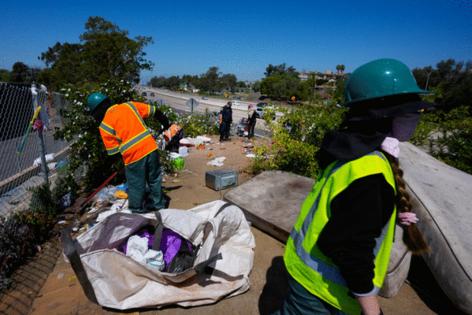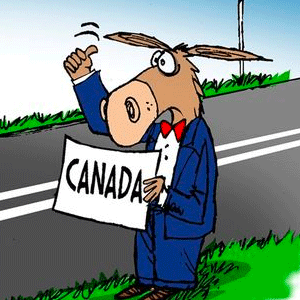San Diego crews are clearing freeway encampments under a new agreement with the state
Published in News & Features
Two groups of people assembled Friday morning on a dirt hill overlooking a freeway.
On one end were more than a dozen individuals in reflective vests. They stood holding shovels and rakes and eyed several mattresses lying on the ground. Closer to the bedding were Maria Garcia, 55, and a man in his 20s. Garcia ignored the crew as she picked up a jug of water and poured it on the man. The flow ran off his bare chest and dripped down toward disintegrating shoes. Garcia used her hands to scrub his back.
When Garcia began sleeping at that spot around a month ago, on the northern edge of San Diego’s Grant Hill neighborhood, she was somewhat insulated from encampment sweeps. Camping bans and other ordinances barred her from living on sidewalks in San Diego, yet city crews weren’t allowed on state-owned land near freeways.
That changed last month.
As of July 16, San Diego police officers, outreach workers and cleaning teams are allowed to clear a roughly 5-mile stretch of property running through downtown, Little Italy, Sherman Heights and Barrio Logan, the result of a contract with the California Department of Transportation, or Caltrans. The 17-page delegated maintenance agreement lasts for one year and says San Diego can be reimbursed up to $400,000 for removing campsites on Caltrans-managed land.
“The homeless encampments along our freeways are not only unsightly, but they are unsafe,” Mayor Todd Gloria said in a statement. “After months of negotiations, I am excited to see this innovative partnership come to fruition.”
Officials said they’ve already visited around two dozen locations, thrown away more than 18 tons of material and gotten at least 10 people into shelters or designated camping areas, often known as safe sleeping sites. (Caltrans also clears encampments, although the process can be slow.)
There’s no question that sleeping near speeding cars increases the chance of accidents, and dozens of possible encampment fires have been reported in recent months near roadways.
At the same time, the new arrangement increases pressure on the thousands of people sleeping outside in San Diego County. There is nowhere near enough shelter for everybody asking — fewer than 6% of all requests for a bed in the city recently succeeded — even as municipalities boost penalties for pitching tents on public land. Federal policy is similarly becoming more aggressive: President Donald Trump issued an executive order in July that said “shifting homeless individuals into long-term institutional settings for humane treatment” is the way to “restore public order.”
In California, Gov. Gavin Newsom told state agencies to speed up sweeps. The directive, however, didn’t come with any extra funding, hampering its effectiveness. One proposal working its way through the Legislature, Senate Bill 569, would now push every city in the state to make deals with Caltrans.
San Diego’s agreement “serves as a model for how the state can partner better with local governments,” state Sen. Catherine Blakespear, D-Encinitas, said in a statement. “By cutting red tape and letting local cities use their processes, we can speed up our response to homeless encampments and more quickly move unsheltered people to safer places where they can get the support they need.”
A comparable deal exists in Los Angeles.
San Diego’s arrangement covers Interstate 5 from the San Diego-Coronado Bridge to Laurel Street; state Route 163 from Ash Street to I-5; and state Route 94 from 17th Street to 30th Street. Cleaning crews will be staffed by city workers, Urban Corps, Alpha Project and Clean Harbors, the latter of which deals with hazardous materials, like needles.
San Diego residents sleeping on Caltrans land should get at least a 48-hour heads up before a sweep.
It’s unclear how long the money might last. It’s additionally possible budget deficits will complicate reimbursements: The contract notes that payments from Caltrans “are contingent upon the Legislature appropriating sufficient funds.”
The crew on Friday waited until Garcia’s makeshift shower had finished. Garcia and the young man weren’t related, but she said she loved him like a son. As people in reflective vests began picking trash up off the ground, a police officer approached the pair. The young man was now in a fresh collared shirt, yet he moved with a limp and could barely stand on his own. He also mumbled and stuttered.
The three huddled for a few moments, speaking in Spanish. Then the officer walked over to Franklin Coopersmith, the city’s deputy director of environmental services.
“She’s saying that he needs medics,” the cop told Coopersmith. “He doesn’t want medics.”
“OK,” Coopersmith said.
“I’m still gonna get a medic,” the officer added.
An ambulance pulled up a little later. Soon the man was lying on a stretcher, surrounded by EMTs.
Garcia gathered what she wanted to keep into shopping carts. (A city official said she declined offers for aid.) Garcia lifted one bin onto the freeway shoulder and used a rope to drag it along the asphalt, toward another dirt trail. Cars roared past. Crew members watched nervously.
The cleanup continued. Bags vanished into a garbage truck. Metal crunched, glass tinkled.
After about an hour the area was mostly clear. A staffer snapped a few photos and made a note that the surrounding fence lacked a gate. San Diego officials are planning to send Caltrans a list of what properties still need to be locked up.
The ambulance doors closed. Garcia disappeared down the hill.
_____
(Union-Tribune reporter Olivia Petty contributed to this report.)
_____
©2025 The San Diego Union-Tribune. Visit sandiegouniontribune.com. Distributed by Tribune Content Agency, LLC.







Comments